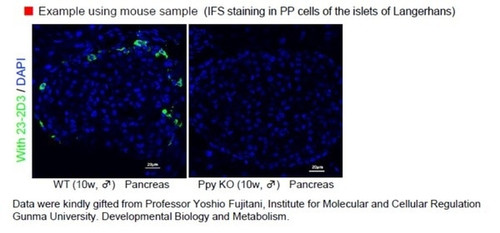Pancreatic Polypeptide (PP) is 36 amino acid polypeptide that is secreted by PP cells (F cells or γ cells) of the islets of Langerhans of pancreas and it is classified as NPY family peptide along with Peptide YY (PYY) and Neuropeptide Y (NPY). The receptors of these NPY family consist of 5 subtypes such as Y1, Y2, Y4, Y5 and Y6 and PP has especially high affinity with Y4 receptor and it has been known as a satiety factor that suppress appetite by acting on Y4 receptor in the hypothalamus.
Recently, it has been reported that PP possibly acts as a blood glucose control factor that suppress the secretion of glucagon by acting on Y4 receptor of alpha cells after glucose loading.
It has been also considered that PP is secreted through stimulating of the vagus nerve after meal and it is involved in the regulation of food intake.
Highly specific antibody is required for PP study since it has been reported that PP cells produce both PP and PYY and these amino acid sequences have high homology.
This antibody specifically reacts to PP in Human, Rat and Mouse and it can be used for Immunohistochemistry (Immunofluorescence staining and DAB staining) against PP cells of the islets of Langerhans. For research use only, not for use in diagnostic procedures.
- application:
- IHC
- Catalog number:
- 10501
- clone:
- 23-2D3
- concentration:
- Please see datasheet
- Datasheet:
- formulation:
- Lyophilized product from 1% BSA in PBS containing 0.05% NaN3
- immunogen:
- Synthetic peptide for Mouse PP
- isotype:
- IgG1
- MSDS:
- notes:
- For research use only, not for use in diagnostic procedures.
The datasheet for this product (see above) is intended to serve as an example only. Please refer to the datasheet provided with the antibody for precise details. - Protocol:
- size:
- 50 µg
- storage:
- Lyophilized product, 5 years at 2 - 8 °C; Solution, 2 years at -20 °C
- Species:
- Human
- Host:
- Mouse
- References:








